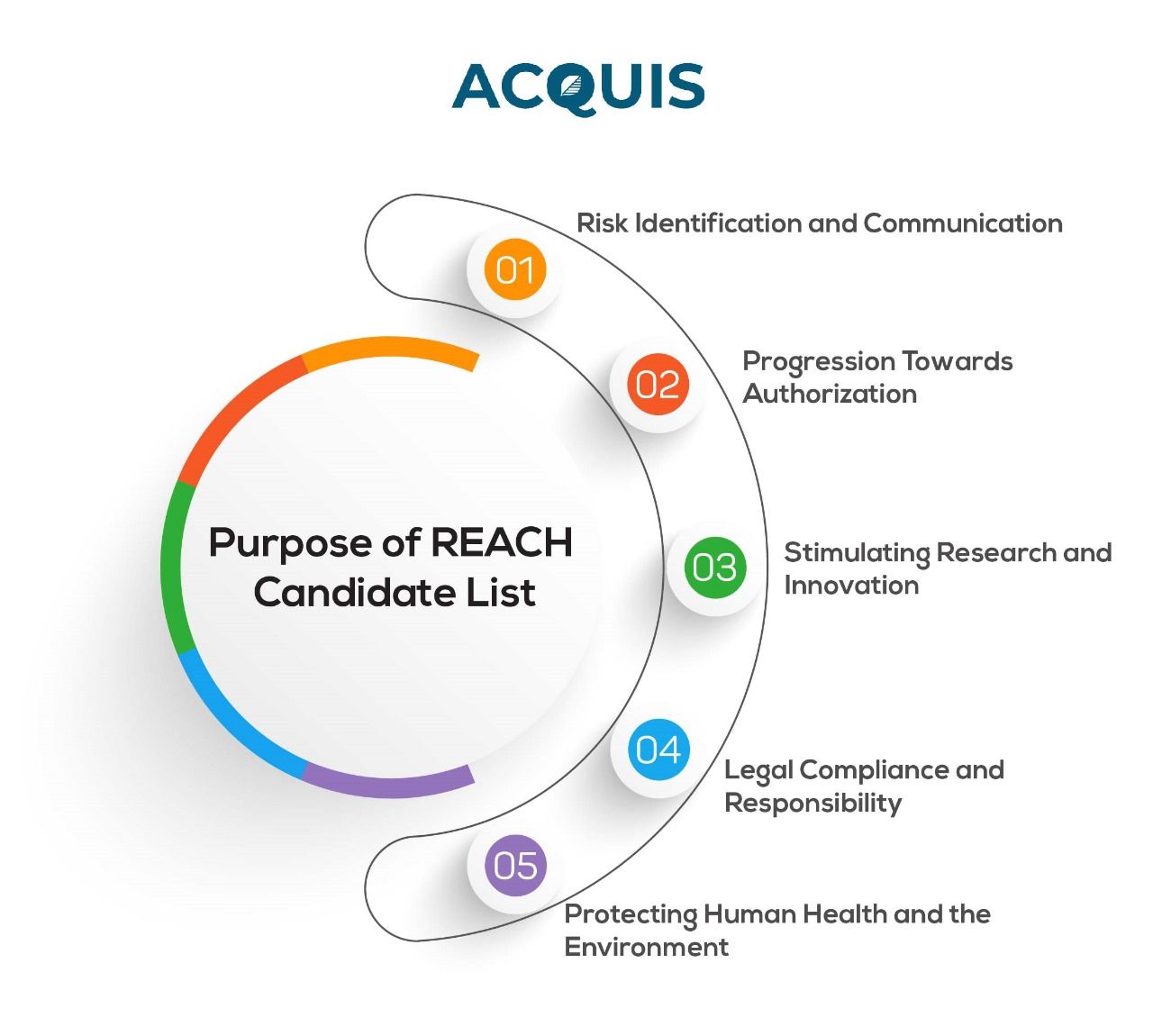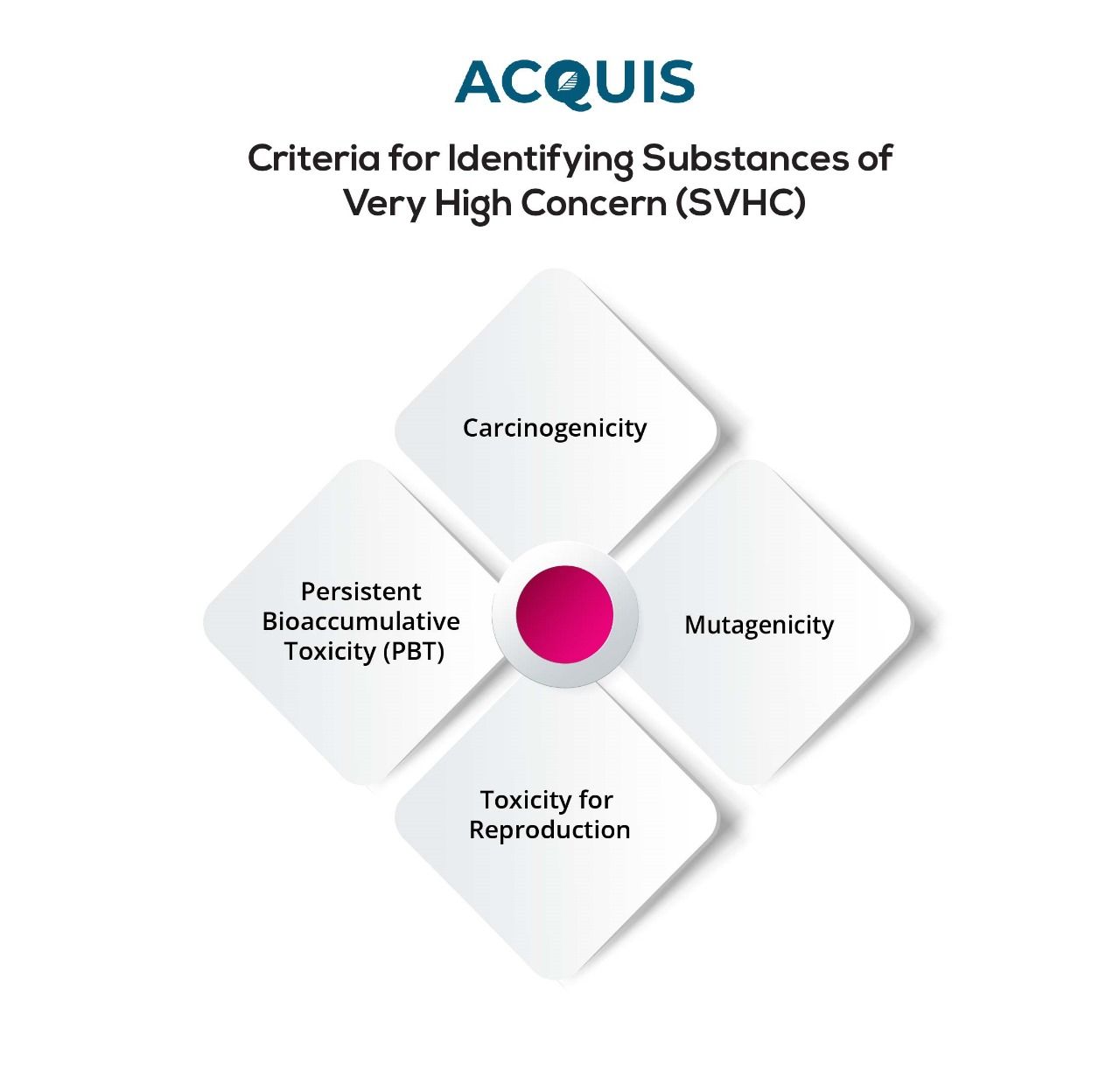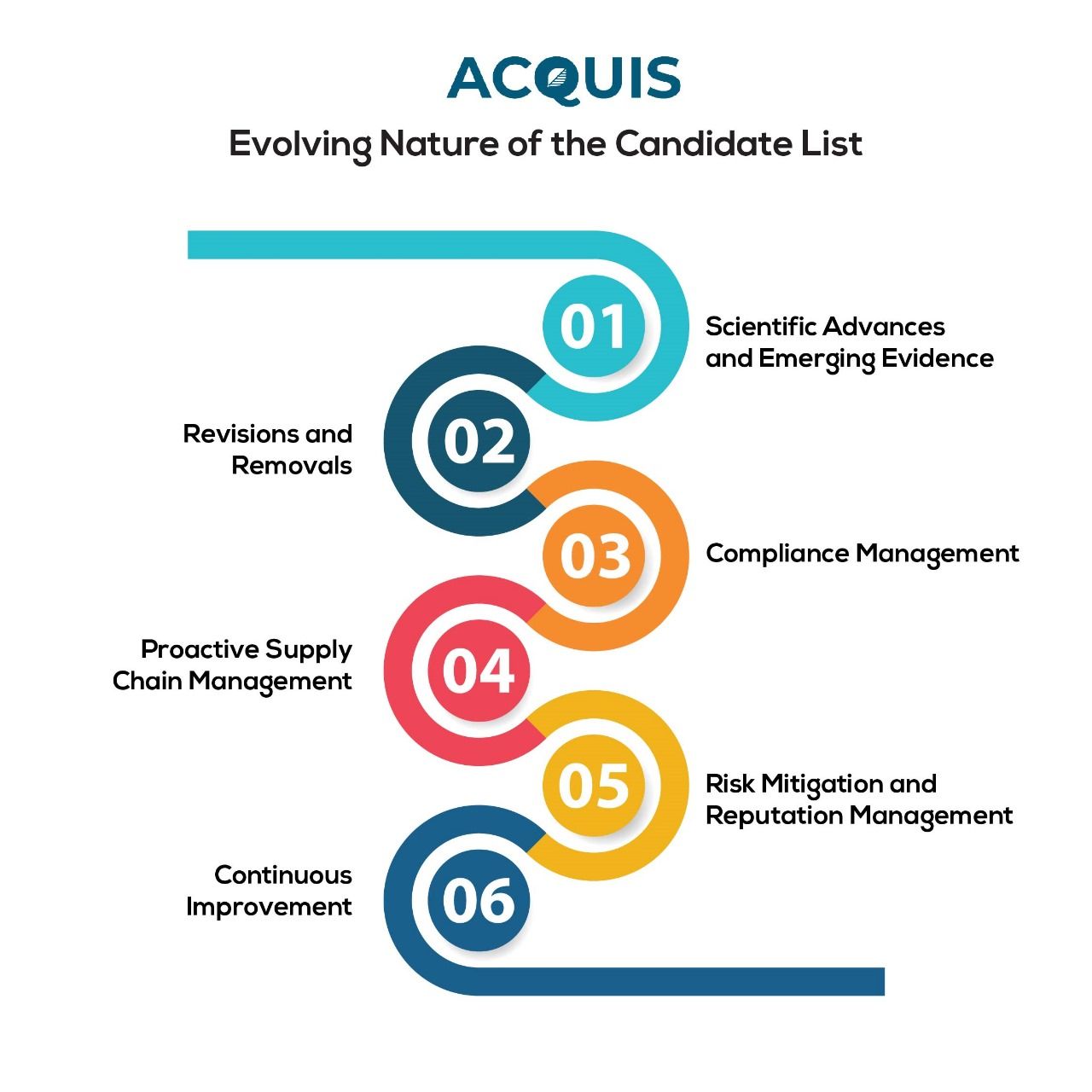Table of Contents
Registration, Evaluation, Authorization, and Restriction of Chemicals (REACH) is a comprehensive regulation established by the European Union (EU) to ensure the safe use of chemicals in various industries. One crucial aspect of REACH is the Candidate List, which identifies Substances of Very High Concern (SVHC). A pivotal component within the REACH framework is the Candidate List, a dynamic inventory that plays a crucial role in identifying Substances of Very High Concern (SVHC).
These SVHCs, due to their inherent hazardous properties, trigger specific regulatory actions aimed at mitigating their impact on both human health and the environment.
Purpose of REACH SVCH Candidate List:
The REACH Candidate List, also known as Substances of Very High Concern (SVHC), is a list of chemical substances that may be harmful to human health or the environment. These substances are subject to further evaluation and may be included in the Authorization List.

The primary objective of the Candidate List is to highlight substances with properties that may have serious effects on human health or the environment. Inclusion in the Candidate List is a step towards authorization, as substances on this list may eventually face restrictions or be banned if safer alternatives are available.
This dynamic inventory is instrumental in achieving several key objectives within the broader framework of REACH:
- Risk Identification and Communication:
○ The Candidate List acts as an early warning system, bringing attention to substances that exhibit properties of Very High Concern (SVHC). These concerns may include carcinogenicity, mutagenicity, toxicity for reproduction, and persistent bioaccumulative toxicity, among others.
○ By highlighting these substances, the list serves as a mechanism for transparent communication within the supply chain, ensuring that all stakeholders are aware of potential risks associated with specific chemicals.
- Progression Towards Authorization:
○ Inclusion in the Candidate List is a critical step in the journey toward authorization. Substances listed as SVHCs may be subjected to further scrutiny, and their usage may be restricted or even banned if safer alternatives are available and feasible.
○ This aspect of the Candidate List aligns with the precautionary principle, emphasizing the proactive management of potential risks before they escalate.
- Stimulating Research and Innovation:
○ The identification of substances in the Candidate List stimulates research and innovation in the development of safer alternatives. It encourages industries to explore and adopt alternative substances or technologies that mitigate the potential adverse effects associated with SVHCs.
- Legal Compliance and Responsibility:
○ Inclusion in the Candidate List imposes legal obligations on manufacturers, importers, and downstream users. It signals the necessity for these stakeholders to communicate relevant information on the safe use of SVHCs and to explore substitution options where applicable.
○ Compliance with the Candidate List contributes to a culture of responsibility, ensuring that the chemical industry operates within the bounds of established safety standards.
- Protecting Human Health and the Environment:
○ Ultimately, the overarching purpose of the Candidate List is to protect human health and the environment by systematically addressing and mitigating the risks posed by SVHCs. This aligns with the EU's commitment to sustainable development and the well-being of its citizens.
Criteria for Identifying Substances of Very High Concern (SVHC)

The identification of Substances of Very High Concern (SVHC) under the REACH framework is a meticulous process guided by specific criteria. SVHCs are substances that exhibit properties and characteristics that warrant heightened attention due to their potential adverse effects on human health and the environment. The criteria for designating substances as SVHCs encompass a range of hazardous attributes:
- Carcinogenicity: Substances with the potential to cause cancer fall within the scope of SVHC criteria. Carcinogenicity refers to the ability of a substance to induce cancer in living tissues, making it a significant concern for human health.
- Mutagenicity: SVHCs include substances that possess mutagenic properties. Mutagenicity relates to a substance's ability to induce genetic mutations, which can have profound implications for both current and future generations.
- Toxicity for Reproduction: Substances exhibiting toxicity for reproduction are considered SVHCs. This criterion pertains to adverse effects on sexual function and fertility, as well as potential harm to the developing fetus during pregnancy.
- Persistent Bioaccumulative Toxicity (PBT): Persistence, bioaccumulation, and toxicity are key factors in designating substances as SVHCs. Persistence refers to a substance's resistance to degradation, bioaccumulation pertains to its tendency to accumulate in living organisms, and toxicity reflects its potential to cause harm.
Lifecycle Approach in REACH:
In the realm of chemical management, the Registration, Evaluation, Authorization, and Restriction of Chemicals (REACH) framework in the European Union operates on a groundbreaking lifecycle approach. This approach, central to REACH's effectiveness, encompasses the entire journey of a chemical substance, from its production or import to its eventual end-of-life stage. At the outset, manufacturers and importers are mandated to register substances, providing in-depth information about their properties and uses.
The subsequent evaluation by the European Chemicals Agency (ECHA) scrutinizes this data, ensuring accuracy and identifying potential risks. Crucially, the lifecycle approach extends to the authorization and restriction phases, empowering authorities to scrutinize and control hazardous substances. Transparent communication down the supply chain is emphasized, facilitating informed decision-making. Importantly, REACH's commitment doesn't end with the product's use; it extends to end-of-life considerations, addressing waste disposal and ensuring responsible management. This comprehensive lifecycle perspective underscores the EU's dedication to sustainable development, safeguarding human health, and fostering responsible practices within the chemical industry
Implications for Manufacturers and Importers:
In the intricate landscape of the Registration, Evaluation, Authorization, and Restriction of Chemicals (REACH), manufacturers and importers bear a pivotal responsibility. When their articles contain Substances of Very High Concern (SVHCs) exceeding a concentration of 0.1% weight by weight, a mandatory obligation unfolds — the imperative to communicate information about these substances throughout the supply chain. This obligation, while regulatory in nature, transcends compliance; it is a catalyst for increased awareness. By transparently sharing details about SVHCs, manufacturers and importers contribute to a collective understanding, fostering a culture of informed decision-making among downstream users. Crucially, this heightened awareness serves as a driving force for change. It encourages the exploration and adoption of safer alternatives, propelling the industry towards a more sustainable trajectory. In essence, the implications for manufacturers and importers extend beyond regulatory compliance; they play a pivotal role in steering the course towards a safer, more environmentally conscious future.
REACH SVCH Authorization Process:
The Authorization Process, a crucial component of the REACH regulation, comes into play once a substance earns a spot on the Candidate List of Substances of Very High Concern (SVHCs). A distinctive feature of the authorization process is that it doesn't provide indefinite permission. Instead, it grants authorization for a limited period, introducing a dynamic element that encourages companies to actively seek and adopt alternatives during this timeframe.
If a substance is added to SVHC list, that does not mean it is banned. However, if the substance is further added to REACH authorization list, it cannot be placed on the EU market or used after a given date, unless an authorization is granted for their specific use, or the use is exempted from authorisation.
Role in Product Compliance and Market Access:
The role of the Candidate List in product compliance and market access is pivotal, particularly for companies seeking to operate within the European Union (EU). Compliance with this list is indispensable for businesses aiming to access the European market, as it directly aligns with the regulatory framework established by the REACH regulation. For companies outside the EU, ensuring that their products adhere to REACH requirements is not just a matter of regulatory compliance; it is a strategic imperative to avoid disruptions in trade. The EU market is stringent in its chemical safety standards, and products containing substances listed as Candidates for Authorization face scrutiny. By adhering to the Candidate List, companies enhance their product compliance, enabling smoother access to the European market.
Evolving Nature of the Candidate List:
The evolving nature of the Candidate List underscores the need for businesses to adopt a proactive and adaptive approach to chemical management. Staying informed about updates, assessing the implications for products and supply chains, and actively seeking safer alternatives contribute to a resilient and compliant business strategy in the context of REACH regulations. Timely awareness of updates to the Candidate List is crucial for companies to maintain compliance with regulatory standards and proactively address any implications for their products and supply chains. Here are key considerations regarding the evolving nature of the Candidate List:

- Scientific Advances and Emerging Evidence:
● New substances may be added to the Candidate List as scientific research progresses and unveils potential hazards associated with certain chemicals. This reflects a commitment to continuously improving our understanding of chemical safety.
- Revisions and Removals:
● Existing listings on the Candidate List may be revised based on updated scientific assessments or regulatory considerations. Additionally, substances may be removed if evidence suggests that they no longer meet the criteria for identification as SVHCs.
- Compliance Management:
● Businesses need to stay vigilant and informed about updates to the Candidate List to ensure continued compliance with REACH regulations. This involves monitoring announcements from regulatory authorities and promptly assessing the implications for their products and processes.
- Proactive Supply Chain Management:
● Proactively addressing changes to the Candidate List is crucial for supply chain management. Businesses should communicate with suppliers, assess the presence of listed substances in their products, and explore alternatives if necessary.
- Risk Mitigation and Reputation Management:
● Promptly addressing the inclusion of substances in the Candidate List helps companies mitigate potential risks associated with regulatory non-compliance. This proactive stance also contributes to reputation management, showcasing a commitment to product safety and regulatory adherence.
- Continuous Improvement:
● Embracing the evolving nature of the Candidate List can be an opportunity for businesses to engage in continuous improvement. This includes adopting a mindset of innovation, exploring alternative materials, and enhancing product sustainability.
Global Impact and Reach Beyond the EU:
REACH's global impact manifests through its influence on supply chains that extend beyond EU borders and its role in shaping international standards for chemical management. By setting a precedent for comprehensive and stringent regulations, REACH has catalyzed a global movement towards responsible and sustainable chemical practices, emphasizing the interconnectedness of the world economy and the importance of harmonizing standards to ensure the safety of products in the global marketplace. Two key aspects underscore the reach and influence of REACH beyond the EU:
- Global Supply Chains:
● Companies operating outside the EU are significantly affected by REACH if they intend to export products to the European market. Compliance with REACH regulations is not limited to EU-based businesses; it is a prerequisite for any company seeking to engage in trade with the EU.
● This has profound implications for global supply chains, as manufacturers and suppliers worldwide must align their practices with the requirements stipulated by REACH to ensure the seamless flow of goods into the European market. Non-compliance can lead to disruptions in trade and market access.
- Global Standard Influence:
● REACH's impact transcends the EU, exerting influence on global chemical management standards. The robust and comprehensive nature of REACH has positioned it as a benchmark for chemical regulations, encouraging other regions and countries to adopt similar approaches in their regulatory frameworks.
● The influence of REACH contributes to the harmonization of chemical safety standards globally. As countries recognize the efficacy and significance of REACH, they are more inclined to implement comparable measures to safeguard human health and the environment, fostering a shared commitment to responsible chemical management.
Future Trends and Evolving Regulations:
The future of chemical management, especially within the REACH regulation, is characterized by a dynamic landscape cantered on the Candidate List. This list, reflecting the evolving understanding of chemical safety, undergoes regular updates to address emerging concerns. Companies in the manufacturing and importing sectors must stay informed about these updates, including additions, revisions, or removals, to ensure compliance and adapt to changing regulatory requirements. As scientific knowledge advances, new concerns may lead to the identification of additional Substances of Very High Concern (SVHCs), prompting a proactive approach to chemical management. Businesses are advised to establish mechanisms for continuous monitoring, assess and mitigate risks, explore alternative solutions, engage stakeholders for insights, and invest in research and development to align with evolving regulatory and sustainability goals. In summary, a proactive and adaptive approach is crucial for businesses to navigate the evolving landscape of chemical management and maintain compliance with emerging regulatory standards.
Conclusion:
The REACH Candidate List plays a pivotal role in promoting the safe use of chemicals and encouraging the transition to more sustainable practices in the EU and beyond. By understanding the implications of SVHC designation, businesses can proactively address regulatory requirements, reduce environmental and health risks, and contribute to a safer and more sustainable future. As the Candidate List continues to evolve, staying informed and adapting to changes will be essential for companies operating in the chemical industry.
